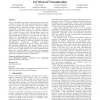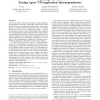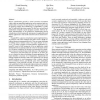201
Voted
VEE
2014
ACM
10 years 7 months ago
2014
ACM
Abstractions Galen Hunt Principal Researcher Microsoft Research Operating Systems Group 1
151
Voted
VEE
2012
ACM
13 years 8 months ago
2012
ACM
OS-level virtualization generates a minimal start-up and run-time overhead on the host OS and thus suits applications that require both good isolation and high efficiency. However...
144
click to vote
VEE
2012
ACM
13 years 8 months ago
2012
ACM
Process-level virtualization is increasingly being used to enhance the security of software applications from reverse engineering and unauthorized modification (called software p...
185
Voted
VEE
2012
ACM
13 years 8 months ago
2012
ACM
Applications written in dynamically typed scripting languages are increasingly popular for Web software development. Even on the server side, programmers are using dynamically typ...
164
click to vote
VEE
2012
ACM
13 years 8 months ago
2012
ACM
Flexible and efficient runtime design requires an understanding of the dependencies among the components internal to the runtime and those between the application and the runtime...
174
click to vote
VEE
2012
ACM
13 years 8 months ago
2012
ACM
Time Of Check To Time Of Use (TOCTTOU) race conditions for file accesses in user-space applications are a common problem in Unix-like systems. The mapping between filename and i...
159
click to vote
VEE
2012
ACM
13 years 8 months ago
2012
ACM
Process virtualization provides a virtual execution environment within which an unmodified application can be monitored and controlled while it executes. The provided layer of co...
161
click to vote
VEE
2012
ACM
13 years 8 months ago
2012
ACM
Checkpoint-recovery based virtual machine (VM) replication is an attractive technique for accommodating VM installations with high-availability. It provides seamless failover for ...
155
click to vote
VEE
2012
ACM
13 years 8 months ago
2012
ACM
In software for embedded systems, the frequent use of interrupts for timing, sensing, and I/O processing can cause concurrency faults to occur due to interactions between applicat...
156
Voted
VEE
2012
ACM
13 years 8 months ago
2012
ACM
With the shift to many-core chip multiprocessors (CMPs), a critical issue is how to effectively coordinate and manage the execution of applications and hardware resources to overc...




